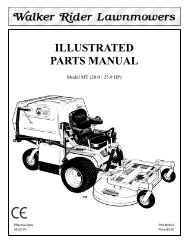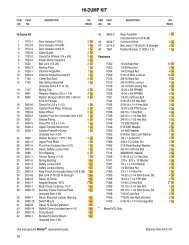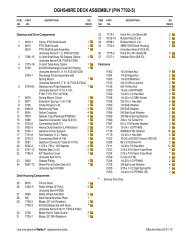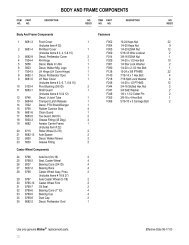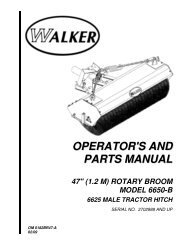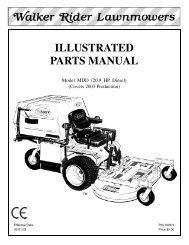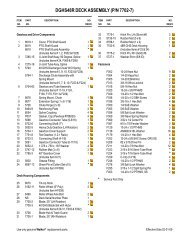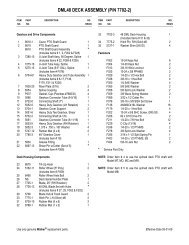1998 S/N 21329 - Walker Mowers
1998 S/N 21329 - Walker Mowers
1998 S/N 21329 - Walker Mowers
You also want an ePaper? Increase the reach of your titles
YUMPU automatically turns print PDFs into web optimized ePapers that Google loves.
Operating Instructions<br />
• Check that the openings in the removable air<br />
exhaust screen in the grass catcher are not<br />
plugged. If the screen is clogged, refer to Cleaning<br />
the GHS Exhaust Screen in this section.<br />
Remember, anything that restricts airflow or material<br />
flow along the entire path from the mower deck to<br />
the grass catcher can cause clogging.<br />
Using the Tilt-Up Deck<br />
Refer to CLEANING of Grass Buildup in Mower<br />
Housing for Tilt-Up Decks in Maintenance<br />
Instructions.<br />
Using the GHS Catcher<br />
Powerfil ®<br />
The GHS catcher has an oscillating grass delivery<br />
spout (POWERFIL ® ) which is designed to spread<br />
grass clippings throughout the interior of the grass<br />
catcher (even when mowing wet, heavy grass). The<br />
oscillating action may be checked by turning the<br />
ignition switch to the ON position and moving the<br />
blade clutch to the ENGAGED position. The spout<br />
should oscillate approximately 25 cycles per<br />
minute.<br />
NOTE: If the grass spout fails to oscillate, the clutch<br />
switch should be checked for function (the switch<br />
closure is adjustable).<br />
“Full” Signal Horn<br />
The GHS catcher has a “full” signal horn to alert<br />
the operator to dump the catcher when it is full (to<br />
prevent overfilling and clogging). The “full” signal<br />
horn is activated by a vane switch (Grass-Pak ®<br />
switch) mounted on the grass delivery spout. Oscillating<br />
action of the spout triggers the vane switch as<br />
grass begins to fill in around the spout when the<br />
catcher is almost full.<br />
The “full” signal function may be checked by turning<br />
the ignition switch ON, engaging the blade clutch<br />
(engine not running), opening the catcher back door,<br />
and triggering the Grass-Pak ® vane by hand as it<br />
oscillates. The horn should sound as the switch is<br />
moved in both directions.<br />
WARNING<br />
DO NOT test the Grass-Pak ® switch with<br />
the engine running. Projectiles may be<br />
thrown out of the grass delivery spout,<br />
and COULD cause serious injury.<br />
The “full” signal horn is designed to operate (sound)<br />
when the grass catcher is almost full. The timing of<br />
the signal is adjustable by changing the position of<br />
the vane on the Grass-Pak ® switch. If the signal is<br />
coming on too soon (catcher not completely full) or<br />
too late (grass clogging in catcher spout and delivery<br />
chute), refer to ADJUSTMENTS of GHS “Full”<br />
Signal Horn in Maintenance Instructions.<br />
NOTE: The horn signal should be adjusted to<br />
sound BEFORE the catcher is completely full to<br />
give the operator time to react and stop mowing. An<br />
indication the horn signal is coming on too late (delayed<br />
too much) is if grass clippings are falling out of<br />
the grass catcher delivery chute when the catcher is<br />
dumped.<br />
Cleaning the GHS Exhaust Screen<br />
To remove the grass catcher screen for cleaning,<br />
open the catcher door, push forward and pull down<br />
on the grass catcher screen knobs (on either side of<br />
the screen), and slide the screen out. Use a high<br />
pressure washer or water spray and brush to clean<br />
the screen.<br />
Keeping the catcher exhaust screen clean and open<br />
is essential to good performance of the catching<br />
system. In some mowing conditions, e.g., wet and<br />
dirty, it will be necessary to clean the screen frequently<br />
to avoid clogging the mower deck, blower,<br />
and chutes due to airflow restriction.<br />
Grass Catcher<br />
Screen<br />
Removal<br />
Knobs<br />
Grass Catcher Screen Removal for Cleaning<br />
40




